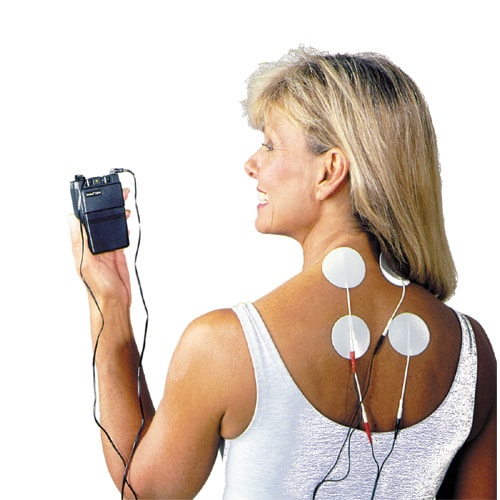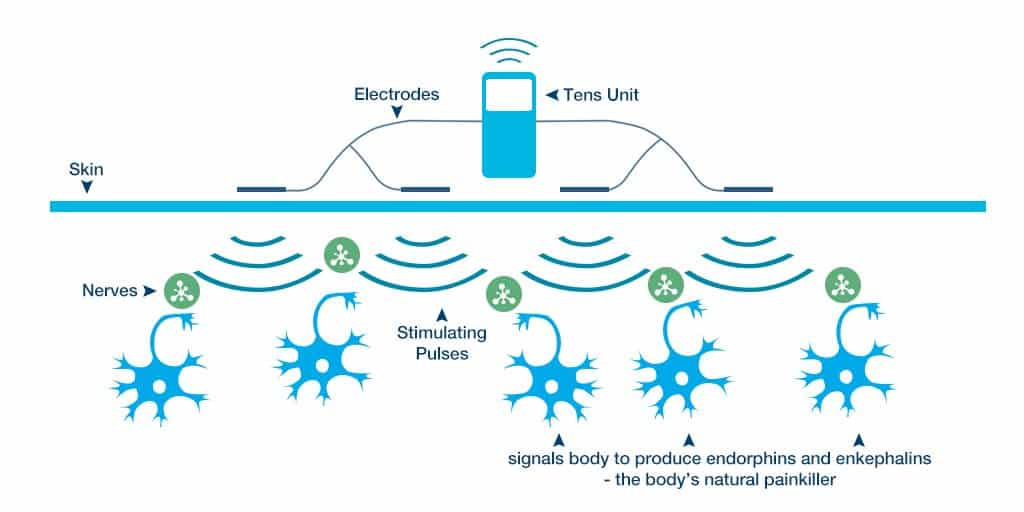
Acute and chronic pain management can be effectively managed with the use of a TENS Machine both inside the clinic as well as by the patient in the comfort of their own home. If clinically indicated, we recommend the home use of a TENS machine in between clinical appointments to help manage pain and recover faster by doing so.
WHAT IS A TENS MACHINE?
TENS is a method of electrical stimulation which primarily aims to provide a degree of symptomatic pain relief by exciting sensory nerves and thereby stimulating either the pain gate mechanism and/or the opioid system.
The effectiveness of TENS varies with the clinical pain being treated, but research would suggest that when used ‘well’ it provides significantly greater pain relief than a placebo intervention.
HOW DOES IT WORK?
The type of stimulation delivered by the TENS unit aims to excite (stimulate) the sensory nerves, and by so doing, activate specific natural pain relief mechanisms. Consider two pain releif mechanisms which it targets: the Pain Gate Mechanism and the Endogenous Opioid System.

The Pain Gate Mechanism – soothing pulses are sent from the TENS unit through the pads to the skin. The pulses then travel along the connecting nerve fibers, suppressing pain signal to the brain. There is a neural mechanism that acts as a kind of gate. Whether the gate is open, closed, or partially closed depends on what sort of signal it receives from the brain to change the perception of pain in the user’s body, and help block the pain message transmission to the brain.
Pain relief by means of the pain gate mechanism involves activation (excitation) of the A beta (Aβ) sensory fibres, and by doing so, reduces the transmission of the noxious stimulus from the ‘c’ fibres, through the spinal cord and hence on to the higher centres. The Aβ fibres appear to appreciate being stimulated at a relatively high rate (in the order of 80 – 130 Hz or pps).
An alternative approach is to stimulate the A delta (Aδ) fibres which respond preferentially to a much lower rate of stimulation (in the order of 2 – 5 Hz, though some authors consider a wider range of 2 – 10Hz), which will activate the opioid mechanisms, and provide pain relief by causing the release of an endogenous opiate (encephalin) in the spinal cord which will reduce the activation of the noxious sensory pathways.
A third possibility is to stimulate both nerve types at the same time by employing a burst mode stimulation. In this instance, the higher frequency stimulation output (typically at about 100Hz) is interrupted (or burst) at the rate of about 2 – 3 bursts per second. When the machine is ‘on’, it will deliver pulses at the 100Hz rate, thereby activating the Aβ fibres and the pain gate mechanism. For some patients this is by far the most effective approach to pain relief, though as a sensation, numerous patients find it less acceptable than some other forms of TENS as there is more of a ‘grabbing’, ‘clawing’ type sensation and usually more by way of muscle twitching than with the high or low frequency modes.
WHAT SETTINGS TO USE?
TRADITIONAL TENS – Usually uses stimulation at a relatively high frequency (80 – 130Hz) and employ a relatively narrow (short duration) pulses though as mentioned above, there is less support for manipulation of the pulse width in the current research literature. Most patients seem to find best effect at around 200s (microseconds). The stimulation is delivered at ‘normal’ intensity – definitely there but not uncomfortable. 30 minutes is probably the minimal effective time, but it can be delivered for as long as needed. The main pain relief is achieved during the stimulation, with a limited ‘carry over’ effect – i.e. pain relief after the machine has been switched off.
FREQUENCY SELECTION – Acute pain is usually most effective between 80 and 120 Hz. Chronic pain can also benefit from lower settings 2 to 10Hz that stimulates an endorphin release. A setting between 35 and 50Hz is commonly used to stimulate muscles for strengthening or even relaxation.
STIMULATION INTENSITY – As a general guide, it appears to be effective to go for a ‘definitely there but not painful’ level for the normal (high) TENS, and a ‘strong but not painful’ level for the acupuncture (lo) mode. There is a growing body of evidence that suggests that a ‘strong’ sensation, whichever mode is being used, might achieve better clinical effects.
ELECTRODE PLACEMENT – In order to get the maximal benefit from the modality, target the stimulus at the appropriate spinal cord level (appropriate to the pain). Placing the electrodes either side of the lesion – or pain areas, is the most common mechanism employed to achieve this.
CONTRAINDICATIONS
Patient who is unable to comprehend instructions, Application over trunk, abdomen or pelvis during pregnancy, TENS during labor for pain relief is both safe and effective, Allergic response to electrode, gel or tape, Electrode placement over dermatological lesion, Anterior aspect of neck or carotid sinus and Pacemakers.
CONCLUSION
A TENS Machine is an effective way to manage acute and chronic pain in between appointments in the comfort of your own home. You can use your machine multiple times in a day, whenever you start to feel the pain coming back. If you are in pain before, during or after therapeutic exercises, put the TENS on before and after for 30 minutes with heat on top before and ice on top after if pain is intense.
Please contact us if you have any questions on how to set up your TENS or the proper placement of the pads for your condition, if you would like more information or want to know if a TENS is right for you.
Follow us on Facebook and Instagram for the latest updates and information. @CCCOSTEOPATHY @COMMUNITYCHIROPRACTICCENTER.


